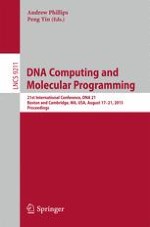This book constitutes the refereed proceedings of the 21st International Conference on DNA Computing and Molecular Programming, DNA 21, held in Boston and Cambridge, MA, USA, in August 2015.
The 13 full papers presented were carefully selected from 63 submissions. The papers address all current issues related to biomolecular computing, such as: algorithms and models for computation on biomolecular systems; computational processes in vitro and in vivo; molecular switches, gates, devices, and circuits; molecular folding and self-assembly of nanostructures; analysis and theoretical models of laboratory techniques; molecular motors and molecular robotics; studies of fault-tolerance and error correction; software tools for analysis, simulation, and design; synthetic biology and in vitro evolution; applications in engineering, physics, chemistry, biology, and medicine.
